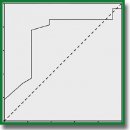
Prognostic Value of Investigating Neuron-Specific Enolase in Patients with Ischemic Stroke
The aim of the study was to assess the prognostic value of the plasma neuron-specific enolase (NSE) level as a predictor of functional outcome and motor function recovery in the acute period of ischemic stroke (IS).
Materials and Methods. Fifty patients with IS have been examined. On admission to the hospital and at 12–14 days after stroke onset, a clinical and neurological examination have been carried out with the supplementary quantitative assessment of neurological deficit severity according to the National Institutes of Health Stroke Scale (NIHSS), functional outcome according to the Modified Rankin Scale, and Rivermead Mobility Index. Enzyme immunoassay was used to determine NSE concentration in blood plasma in the acute period of the disease.
Results. The NSE level in patients’ blood plasma in the first 48 h after stroke onset positively correlates with the ischemic focus volume (r=0.49; p=0.003) and the severity of neurological symptoms (according to NIHSS) (r=0.33; p=0.02). NSE less than 2 ng/ml in the acute disease period is a predictor of good functional outcome 12–14 days after stroke onset (OR=12.4; р=0.006). The NSE level >2.6 ng/ml is associated with a high likelihood of lethal outcome.
Neurological deficit below 15 according to NIHSS as well as the NSE level <2 ng/ml in the acute IS period are estimated as prognostic factors of significant recovery of motor function at 2 weeks after disease onset (OR=5.8; р=0.02).
Conclusion. Determination of NSE in blood plasma makes it possible to predict functional outcome of the disease development and the recovery of motor function in patients with IS.
- Algin A., Erdogan M.O., Aydin I., Poyraz M.K., Sirik M. Clinical usefulness of brain-derived neurotrophic factor and visinin-like protein-1 in early diagnostic tests for acute stroke. J Emerg Med 2019; 37(11): 2051–2054, https://doi.org/10.1016/j.ajem.2019.02.037.
- Yastrebtseva I.P., Belova V.V., Fokicheva S.O., Karmanova A.S. Results of the mechanized kinezoterapiya at the combination motive and speech violations at patients with the stroke. Vestnik vosstanovitelʹnoj mediciny 2018; 2: 53–58.
- Skripchenko N.V., Shirokova A.S. Neuron-specific enolase and S100 protein as biomarkers of brain damage. Review and clinical application. Nejrohirurgia i nevrologia detskogo vozrasta 2016; 4: 16–25.
- Isgrò M.A., Bottoni P., Scatena R. Neuron-specific enolase as a biomarker: biochemical and clinical aspects. Adv Exp Med Biol 2015; 867: 125–143, https://doi.org/10.1007/978-94-017-7215-0_9.
- Missler U., Wiesmann M., Friedrich C., Kaps M. S-100 protein and neuron-specific enolase concentrations in blood as indicators of infarction volume and prognosis in acute ischemic stroke. Stroke 1997; 28(10): 1956–1960, https://doi.org/10.1161/01.str.28.10.1956.
- Oh S.H., Lee J.G., Na S.J., Park J.H., Choi Y.C., Kim W.J. Prediction of early clinical severity and extent of neuronal damage in anterior-circulation infarction using the initial serum neuron-specific enolase level. Arch Neurol 2003; 60(1): 37–41, https://doi.org/10.1001/archneur.60.1.37.
- Wunderlich M.T., Lins H., Skalej M., Wallesch C.W., Goertler M. Neuron-specific enolase and tau protein as neurobiochemical markers of neuronal damage are related to early clinical course and long-term outcome in acute ischemic stroke. Clin Neurol Neurosurg 2006; 108(6): 558–563, https://doi.org/10.1016/j.clineuro.2005.12.006.
- González-García S., González-Quevedo A., Fernández-Concepción O., Peña-Sánchez M., Menéndez-Saínz C., Hernández-Díaz Z., Arteche-Prior M., Pando-Cabrera A., Fernández-Novales C. Short-term prognostic value of serum neuron specific enolase and S100B in acute stroke patients. Clin Biochem 2012; 45(16–17): 1302–1307, https://doi.org/10.1016/j.clinbiochem.2012.07.094.
- Zaheer S., Beg M., Rizv I., Islam N., Ullah E., Akhtar N. Correlation between serum neuron specific enolase and functional neurological outcome in patients of acute ischemic stroke. Ann Indian Acad Neurol 2013; 16(4): 504–508.
- Singh H.V., Pandey A., Shrivastava A.K., Raizada A., Singh S.K., Singh N. Prognostic value of neuron specific enolase and IL-10 in ischemic stroke and its correlation with degree of neurological deficit. Clin Chim Acta 2013; 419: 136–138, https://doi.org/10.1016/j.cca.2013.02.014.
- Stanne T.M., Åberg N.D., Nilsson S., Jood K., Blomstrand K., Andreasson U., Blennow K., Zetterberg H., Isgaard J., Svensson J., Jern C. Low circulating acute brain-derived neurotrophic factor levels are associated with poor long-term functional outcome after ischemic stroke. Stroke 2016; 47(7): 1943–1945, https://doi.org/10.1161/strokeaha.115.012383.
- Green J., Forster A., Young J. A test-retest reliability study of the Barthel Index, the Rivermead Mobility Index, the Nottingham Extended Activities of Daily Living Scale and the Frenchay Activities Index in stroke patients. Disabil Rehabil 2001; 23(15): 670–676, https://doi.org/10.1080/09638280110045382.
- Blinov D.V. Evaluation of brain-blood barrier permeability for neuron-specific enolase during perinatal hypoxic-ischemic lesion of the CNS. Akuserstvo, ginekologia i reprodukcia 2013; 7(4): 15–19.
- Cheng F., Yuan Q., Yang J., Wang W., Liu H. The prognostic value of serum neuron-specific enolase in traumatic brain injury: systematic review and meta-analysis. PLoS One 2014; 9(9): e106680, https://doi.org/10.1371/journal.pone.0106680.
- Ahmad O., Wardlaw J., Whiteley W.N. Correlation of levels of neuronal and glial markers with radiological measures of infarct volume in ischemic stroke: a systematic review. Cerebrovasc Dis 2012; 33(1): 47–54, https://doi.org/10.1159/000332810.
- Brouns R., De Vil B., Cras P., De Surgeloose D., Mariën P., De Deyn P.P. Neurobiochemical markers of brain damage in cerebrospinal fluid of acute ischemic stroke patients. Clin Chem 2010; 56(3): 451–458, https://doi.org/10.1373/clinchem.2009.134122.
- Thelin E., Jeppsson E., Frostell A., Svensson M., Mondello S., Bellander B.M., Nelson D.W. Utility of neuron-specific enolase in traumatic brain injury; relations to S100B levels, outcome, and extracranial injury severity. Crit Care 2016; 20: 285, https://doi.org/10.1186/s13054-016-1450-y.










